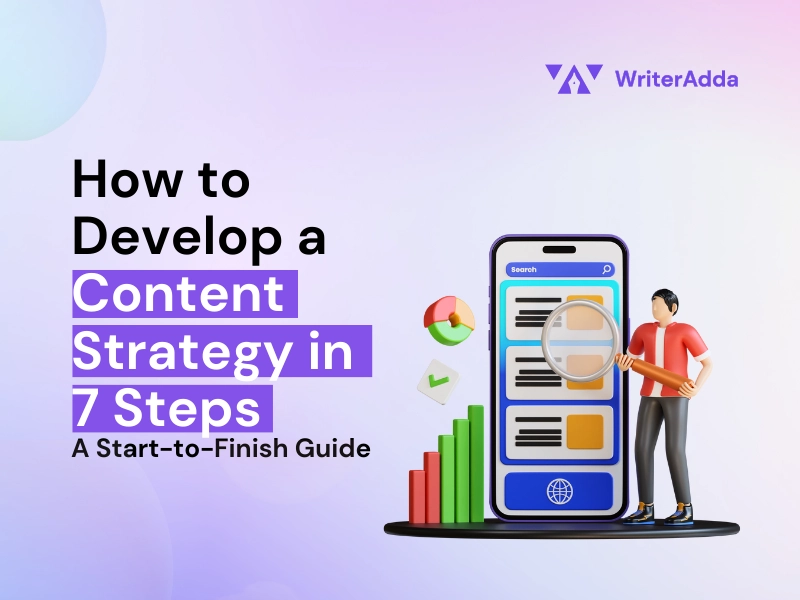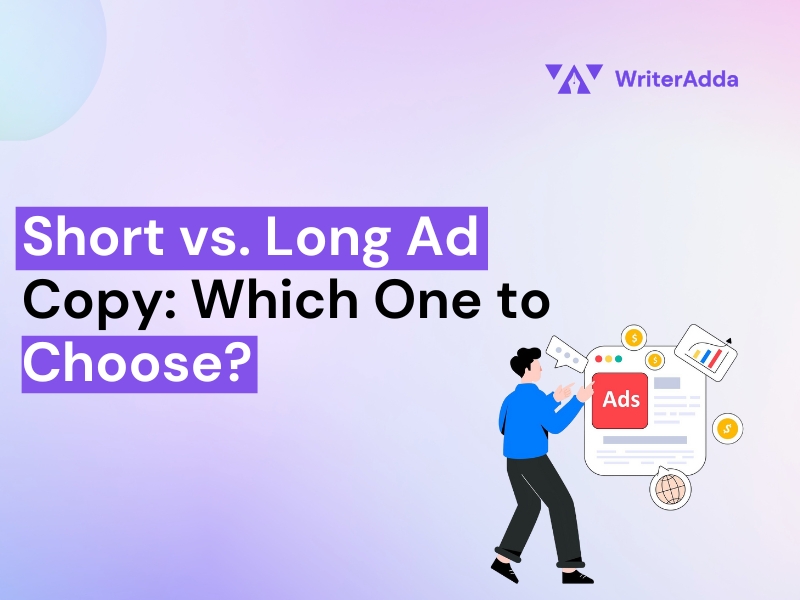A company’s success relies on content marketing as it generates more leads. Whether you’re new to content marketing or have an established strategy, it’s crucial to regularly review and ensure your content is trendy, creative, and engaging for your prospects and customers, regardless of their purchasing intentions or preferences.
Did you know 63% of businesses need a documented content marketing strategy? A content strategy can assist you in reviewing and adjusting your approach, allowing your potential and existing customers to continuously connect with you, regardless of when or how they intend to make a purchase. Your content strategy should prioritize the creation of high-quality material, interaction with your target audience, and tracking your successes and mistakes. This blog will shed light on how to create a content strategy in 7 steps, from start to end.
What is content strategy?
Using content to increase brand recognition can help you accomplish your company’s goal. This can be done by creating an SEO-focused content strategy to increase the visibility of your website on search engine result pages and draw customers to your goods and services. Many brand-new business owners wrongly think they don’t need to start with a content strategy.
However, offering excellent quality can be crucial in building trust with new audiences and gaining a sustained competitive edge. A solid content strategy is essential to an inbound marketing plan since it supports the buyer’s journey stages of attraction and delight. In addition to bringing in new clients, a content strategy may be used to increase sales and customer satisfaction.
Step-by-step Guide to Content Strategy
1) Define your Goals
Great content is developed with a specific goal that must be clearly defined. Determine whether you publish content to increase brand awareness, attract customers, convert leads, improve search engine rankings, or something else. After determining your objectives, you can evaluate if implementing a content strategy is the most effective approach to accomplish them. The content has the potential to provide greater advantages in persuading users who are closer to making a purchase decision, thus improving conversion rates at the final stages of the sales process.
Different content types are appropriate for different parts of the sales funnel. Therefore, you must choose the most relevant information for a person to hear at a particular time. You will converse with the appropriate person at the appropriate moment in this manner.
2) Understand your audience
When developing a content strategy, it’s crucial to determine the subject matter that will effectively communicate with your intended audience and address their concerns. You may generate excellent and pertinent content that appeals to your audience by conducting detailed research that helps you understand their requirements, interests, and pain areas. Identify your target market and gather comprehensive information about their traits, inclinations, and actions. This can be accomplished through various methods such as conducting surveys, and interviews, analyzing social media data, and conducting market research. Tailoring your content to meet the specific needs of your audience requires understanding their identity and preferences
Then, delve more deeply into the issues your audience is facing. Find popular subjects and pertinent keywords associated with your specialty; this requires researching search trends. Look for areas where the present content could be improved that your expertise can fill. Please pay attention to the inquiries people make, the topics they touch on, and the difficulties they face. This qualitative research offers insightful information about the actual issues your audience is facing.
3) Focus on your niche.
Unfortunately, most of today’s stuff shouldn’t exist; it shouldn’t be on the internet. These days, much stuff is either plagiarized from elsewhere or has no intrinsic worth. As a result, it does not rank well in the SERPs, and it never reaches the eyes of the final consumer. Curate content that is distinctive in its own right to prevent this problem. Your writing should have a distinct style and, most importantly, provide readers with real value. Your chances of becoming recognized as an authority in your industry, whether your readers seek knowledge or pleasure, will rise as you focus more narrowly on your niche. It will be simple to spread your message once you concentrate on it.
4) Decide on the format.
You should choose a format for your material based on where your audience is. Despite the popularity of podcasts and YouTube channels in recent years, it’s important to consider that your audience might still have a stronger inclination toward traditional blogging. To put it simply, find out where they are located. Otherwise, you risk wasting your time on a channel that might not provide the attention or results you desire. After determining the appropriate format, it is important to explore strategies for incorporating this approach effectively.
Additionally, multichannel marketing is a successful way to ensure that the target audience sees your content across various channels. By recognizing the diverse platforms where your audience engages, you can effectively promote your brand, establishing a lasting presence in their minds
5) Manage content creation and publishing
For efficient content production and publication, a content strategy must be developed. It entails using a systematic planning, creation, and distribution process to create content that supports organizational objectives and interests the target market. To create an effective content strategy, it’s essential to begin by defining your goals and what you want your content to achieve. This can entail raising brand recognition, boosting website traffic, or producing leads. To fully grasp your target audience’s needs, tastes, and behaviors, undertake extensive research on them. Utilizing this information can create more appealing content for your audience.
Perform competitive research as well to find market opportunities and gaps. This information lets you choose suitable content formats, distribution channels, and publishing schedules. To effectively create and publish your content, it is recommended that you establish an editorial calendar. Topics, key phrases, due dates, and accountable team members must be included. Finally, frequently track and evaluate the effectiveness of your content so that you may make data-driven corrections and enhancements.
6) Use Email-marketing
Setting up specific goals and objectives for your email campaigns is essential. Having a clear goal in mind will direct your content development, whether you want to boost sales, raise brand awareness, or foster customer connections. Next, divide your email list into groups according to demographics, tastes, or other behaviors to ensure that the right people see the pertinent content. Higher engagement rates and personalized communications are made possible by this. To further capture attention and increase open rates, it is crucial to write email copy that is both concise and interesting.
When sending emails, it’s essential to balance staying at the forefront of your subscribers’ minds and not overwhelming them. To do this, carefully consider the timing and frequency of your email communication. For ongoing enhancement of your strategy, regularly analyze email performance metrics such as open rates, click-through rates, and conversion rates. You may create an email marketing plan that is successful and meets your business goals by iteratively improving your approach based on data-driven insights.
7) Track results
To create a successful content strategy, tracking results is essential. Making data-driven decisions and optimizing your upcoming content endeavors are all made possible by being able to gauge the effectiveness and impact of your content efforts. Establishing specific objectives and key performance indicators (KPIs) that align with your overall content objectives is the first step in tracking success. Metrics like website traffic, engagement rates, conversions, or social media reach may be among them. Use analytics software to track often and measure these metrics, such as Google Analytics or social media insights.
Implement UTM parameters or tracking codes to monitor the success of particular campaigns or distribution channels. To gain insights into what content your audience likes, where your traffic comes from, and areas for improvement, analyze the data you have collected. Utilize these insights to continuously improve your content strategy and experiment with various strategies to get better outcomes over time. Remember that tracking results enable you to optimize and produce more excellent results in the future, in addition to helping you understand the success of your content.
7 benefits of developing a content strategy
• Increased Brand Awareness: A content strategy aids in the establishment of a consistent brand voice and message across several channels. It enables firms to reach a larger audience and raise brand awareness.
• Improved Search Engine Visibility: By conducting keyword research and following SEO principles, you can create and optimize content with a higher chance of appearing in search engine results. Developing a content plan can help increase organic traffic and improve your search engine rankings.
• Improved Audience Interaction and Engagement: A content strategy enables the creation of valuable, relevant, and engaging material. This stimulates audience involvement, such as likes, comments, and shares, generating a sense of community and establishing customer relationships.
• Establishing Authority and Credibility: Individuals and corporations can position themselves as experts by constantly offering high-quality and helpful material. The target audience gains trust, credibility, and authority due to this.
• Lead Generation and Conversion: A content strategy can include lead generation methods such as gated content, newsletters, or downloadable materials. Businesses can develop leads and nurture them along the sales funnel by giving good content in exchange for contact information.
• Increased Customer Retention and Loyalty: Providing valuable and relevant information to existing customers regularly helps to keep their interest and loyalty. By enhancing the relationship with customers, encouraging repeat business, and creating brand ambassadors, this approach can lead to significant benefits.
• Data-Driven Decision Making: Tracking and analyzing metrics linked to content performance, audience engagement, and conversions are part of a content strategy. By utilizing this data, you gain valuable insights into effective strategies and areas that require improvement. This knowledge empowers you to make informed decisions when creating and optimizing content going forward.
Conclusion
A well-rounded content strategy may be created by following a complete seven-step method, including goal setting, target audience identification, content research, planning, creation, promotion, and measurement. With a good strategy, organizations can effectively produce excellent content, engage their audience, drive conversions, and ultimately achieve long-term success in the ever-changing digital market.




